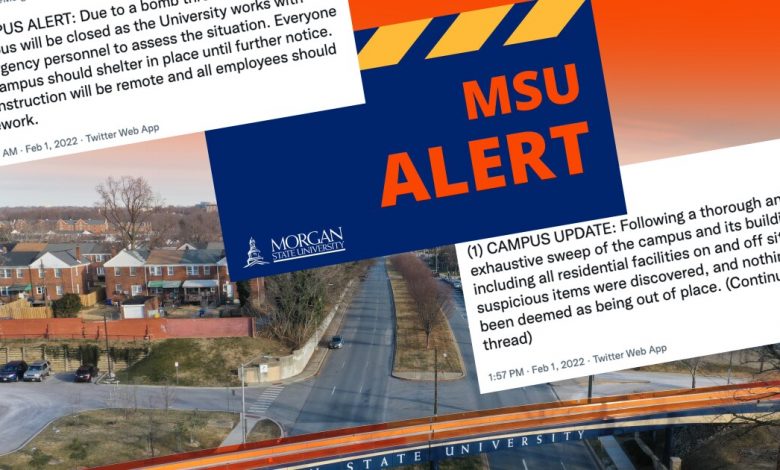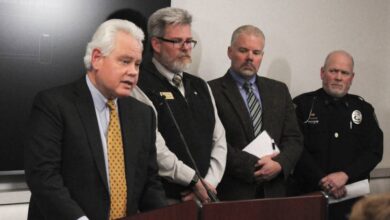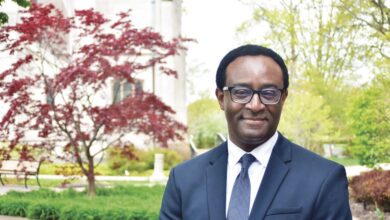Unsettled by Threats, HBCUs Reflect on a Long History of Racist Intimidation

[ad_1]
Fisk University was preparing to host a civil-rights address in its gymnasium when police and fire officials suddenly ordered everyone to evacuate. Someone had called in a bomb threat, and the crowd of nearly 4,000 was left waiting. It took about 45 minutes to clear the building, and no bomb was found.
When he finally took the stage, Martin Luther King Jr. told the audience not to lose hope, The Nashville Banner reported on April 21, 1960. “No lie can live forever. Let us not despair. The universe is with us,” he said.
King was visiting Fisk to offer encouragement to students from historically Black colleges and universities who had been conducting sit-ins to end racial segregation at restaurants in downtown Nashville, part of a larger series of lunch-counter sit-ins across the South in 1960.
During the civil-rights era, HBCUs served as “seed beds for activism” and agency among Black people, said Jelani M. Favors, a historian and professor at North Carolina A&T State University. These institutions offered “an unwritten curriculum” that “was fueled by the idea of creating race consciousness as a counternarrative to the dominant ideas of white supremacy that sought to teach Black children and Black youth,” Favors said.
As Black History Month began, dozens of HBCUs across the country were swarmed with bomb threats for two days in a row. These followed a series of similar threats made in early January. The FBI has identified six persons of interest who are suspected of making the latest round of threats, “which appear to have a racist motivation,” NBC News reported.
When Favors learned of the threats, he wasn’t surprised. “My first initial thought is that this is not new,” he said. Black institutions have been targets of violent threats ever since they were created, said Favors, the author of Shelter in a Time of Storm: How Black Colleges Fostered Generations of Leadership and Activism.
Seeing what’s happening today, Favors said he can’t help but draw parallels to the hostile race relations of the Reconstruction era. “There were a number of people in this country who believed that the ideas of whiteness were under attack, that in some way that whiteness was losing its social and political currency,” he said. “And that is what we see right now.”
While all of the recent threats have so far been found to be meritless, they have unnerved the campuses. And historically, not all bomb threats made against HBCUs have been empty.
In 1999, law-enforcement authorities charged a white man named Lawrence M. Lombardi with planting two small bombs on Florida A&M’s campus. The bombs, detonated within a few weeks of each other, were categorized as “acts of racial hatred.” The blasts were “accompanied by telephone calls laced with expletives” about Black people, Diverse: Issues in Higher Education reported at the time. Lombardi was convicted on several criminal counts and is still in prison.
HBCUs have seen their fortunes improving lately. Many have recently received large philanthropic pledges, several HBCU graduates have risen to political prominence, and some of the colleges have seen a surge in enrollment. People trying to unsettle these institutions are perpetuating a “mental attack,” said Karsonya Wise Whitehead, the founding director of the Karson Institute for Race, Peace, & Social Justice at Loyola University Maryland.
“I’ve always seen our universities, our spaces as potential targets,” said Whitehead, who graduated from Lincoln University, a historically Black institution in Pennsylvania. “If you want to upset Black health and wellness you go after the place where we send our children to be safe.”
Whitehead, who hosts a regular radio show at Morgan State University, said that when she went to the campus, even after officials had issued an “all clear” notice, it felt eerie. It wasn’t the first time the campus had been nearly empty. There was hardly anyone there after the university went virtual because of the pandemic. But this felt different.
“It just felt sad. It felt challenging,” she said. “It made me want to embrace the students and say, ‘Look, we’re going to get through this.’”
Taylor St. Vilus, a sophomore at Southern University and A&M College, in Louisiana, spent hours in her off-campus apartment while officials assessed Monday morning’s bomb threat at the university. “I was very confused at first and then I was a little bit nervous because I remembered other HBCUs receiving a bomb threat,” she said. “It was just very concerning to hear.”
HBCU leaders have put out statements with the central theme of resilience, urging their campuses to continue to move forward, echoing King’s sentiments from over 60 years ago.
“Morgan is one of the most historical and consequential universities in the nation,” said David Wilson, the president of Morgan State University, in a statement. “Our history has been one where we have endured all kinds of challenges and disruptions, but we have always emerged stronger.”
In a video message, Wayne Frederick, the president of the thrice-targeted Howard University, told his campus that the threats were “motivated by hate.” He encouraged the community to “move forward together to counteract the malevolent forces in our society and inspire goodness to triumph.”
[ad_2]
Source link






